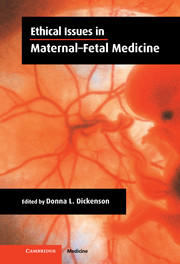Book contents
- Frontmatter
- Contents
- List of contributors
- Acknowledgements
- 1 Introduction: recent debates in maternal–fetal medicine – what are the ethical questions?
- 2 Overview: a framework for reproductive ethics
- I GENERIC ISSUES IN PREGNANCY
- II INCEPTION OF PREGNANCY: NEW REPRODUCTIVE TECHNOLOGIES
- 9 Ethical issues in embryo interventions and cloning
- 10 A case-study in IVF: paternalism and autonomy in a ‘high-risk’ pregnancy
- 11 The ethics of secrecy in donor insemination
- III FIRST AND SECOND TRIMESTER
- IV THIRD TRIMESTER
- V NEONATAL LIFE
- Index
10 - A case-study in IVF: paternalism and autonomy in a ‘high-risk’ pregnancy
from II - INCEPTION OF PREGNANCY: NEW REPRODUCTIVE TECHNOLOGIES
Published online by Cambridge University Press: 29 September 2009
- Frontmatter
- Contents
- List of contributors
- Acknowledgements
- 1 Introduction: recent debates in maternal–fetal medicine – what are the ethical questions?
- 2 Overview: a framework for reproductive ethics
- I GENERIC ISSUES IN PREGNANCY
- II INCEPTION OF PREGNANCY: NEW REPRODUCTIVE TECHNOLOGIES
- 9 Ethical issues in embryo interventions and cloning
- 10 A case-study in IVF: paternalism and autonomy in a ‘high-risk’ pregnancy
- 11 The ethics of secrecy in donor insemination
- III FIRST AND SECOND TRIMESTER
- IV THIRD TRIMESTER
- V NEONATAL LIFE
- Index
Summary
Introduction
Renal transplantation, the treatment of choice for patients with end-stage renal failure, can correct the infertility due to chronic ill health, anaemia and tubal damage generally encountered when these patients are managed by renal dialysis. Currently only 1 in 50 women of child-bearing age becomes pregnant following a renal transplant, and it may be that many more would welcome the chance of biological parenthood if their fertility problems could be overcome. The first successful pregnancy, conceived in 1956 following an identical twin renal transplant, was reported in 1963 (Murray et al., 1963).
Until recently, pregnancy had been thought to present considerable hazards to the transplant recipient. However, some reviews (Sturgiss and Davison, 1992; Davison, 1994) have suggested that pregnancy in the graft recipient, unlike the rare pregnancy in patients undergoing dialysis, is usually likely to lead to a live birth, and that pregnancy may have little or no adverse effect on either renal function or blood pressure in the transplant recipient. The current medical consensus is that if, prior to conception, renal function is well preserved, and if the patient does not develop high blood pressure, only a minority of transplant recipients will experience a deterioration of their renal function attributable to pregnancy (Lindheimer and Katz, 1992).
It is inevitable that the rapid return to good health enjoyed by the majority of women following successful renal transplantation should encourage them to consider conception.
- Type
- Chapter
- Information
- Ethical Issues in Maternal-Fetal Medicine , pp. 161 - 166Publisher: Cambridge University PressPrint publication year: 2002

